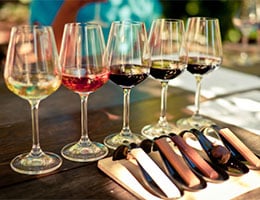 The first meaning of the concept of marriage mentioned by the dictionary of the Royal Spanish Academy ( RAE ) refers to the bond and union of married people . However, the term is usually used to refer to conformity or agreement between different elements.
The first meaning of the concept of marriage mentioned by the dictionary of the Royal Spanish Academy ( RAE ) refers to the bond and union of married people . However, the term is usually used to refer to conformity or agreement between different elements.
Specifically, the usual thing is that the pairing refers to the correspondence between a food and a wine . The concept is a kind of metaphor for marriage : food and alcoholic beverages enter into a "marriage" in a bond that enhances the qualities of both.
For a long time, food and wine were simply combined according to availability in the region. That is to say: people drank and ate whatever was within their reach. Only in recent years has pairing begun to be understood as an art to achieve the best possible amalgamation.
Furthermore, the importance of wine in food is different in each culture : for some it is simply an optional addition, while for others it is an essential component of the table. This is undoubtedly reflected in all areas, since the more relevant a product is for a region, the more presence it will have in its industry, inevitably displacing others.
The sommelier is the expert who usually recommends how to develop the pairing according to the characteristics of the food and the wine. There are restaurants where this specialist suggests to diners which wine to choose based on the dish ordered.
The verb performed by the sommelier is tasting , which is defined as the use of the sense of taste in combination with those of smell and sight to taste a food. The corresponding noun is cata . The ideal conditions that the place where the sommelier works should have are the following:
* a space without odors or aromas that can mix with those of the food to be tasted;
* a good level of lighting, since the visual aspects of the meals are also important for your verdict;
* absence of noise, necessary so you can concentrate;
* a medium temperature , which does not affect the flavors or consistency of the products.
The pairing takes into account the harmonization of flavors , textures and aromas , often creating novel sensations that could not be obtained separately. The goal is to maximize the pleasure derived from the culinary experience.
 A reserve red wine with game meat ; a dry white wine with fish; and a sweet wine with a chocolate dessert are some of the pairings that are often suggested. Of course, taste is subjective and each person can have their preferences beyond the intrinsic properties of foods and wines.
A reserve red wine with game meat ; a dry white wine with fish; and a sweet wine with a chocolate dessert are some of the pairings that are often suggested. Of course, taste is subjective and each person can have their preferences beyond the intrinsic properties of foods and wines.
Throughout the history of pairing, experts have developed a series of rules that they learn during their training, although later in practice they can modify or adapt to the specific conditions of each dish and type of wine available. Below we will see some of these rules:
* To accompany an aperitif, a fortified wine is recommended, the name given to those that are processed by increasing their alcohol content and stability, minimizing the proportion of grapes in their composition;
* stews, stews, legumes and strong cheeses are well combined with full-bodied red wines;
* for prawns, prawns, grilled lobster, oysters and crabs, a light dry white wine is suitable;
* as mentioned above, sweet wines are ideal to complement chocolate desserts, in addition to sponge cakes and puff pastry;
* cavas, on the other hand, can be used with any dish.
